

![[Previous Page]](prev_dis.gif)
![[Next Page]](next.gif)
![[Up]](up.gif)
![[Home Page]](home.gif)
![[Mail]](mail.gif)
![[Contents]](contents.gif)

You'll probably know already most parts of a guitar (sorry, this is about electric guitars, since I don't have an accoustic one, accoustics are made of less different parts anyway and are less complicated). Anyhow, naming them properly helps to communicate with other players or the folks in the stores.
Knowing how they influence the performance of a guitar isn't a bad thing, either.
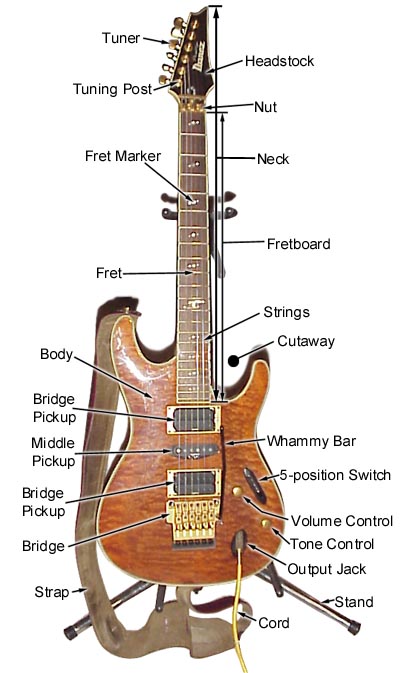 Solid Body
Solid Body
|
The body |
|
The neck |
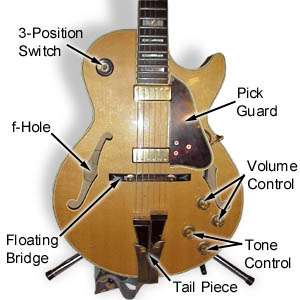 Hollow Body |
The strings
are the main vibrating part of a guitar, they are really important for the sound. On electric guitars they are made out of a magnetic alloy (usually steel and nickel). There are sets of strings in different gauges. A set of ".013s" is considered to be heavy, a set of ".008" is a light set of strings. That number is the diameter of the high E string in inches (1 inch = 25.4mm). Heavy strings have a loud, full tone and the action (distance between string and fretbaord) can be lower. Light strings are easier to bend, but tend to break more easily. Personally I prefer the heavy strings. I play .011s on my solid bodies and .012s or .013s on my hollow bodies. How often you have to replace your strings depends on how much you play them. If you play a lot, you might want to string your guitar every 4 weeks, if you don't play a lot, it can be every 3 months. Wiping off the strings with a cloth after playing prolongs the strings life.
The bridge
is the 2nd anchor point of the string. It is important for the energy transfer between the strings and the body, too. Most bridges can be adjusted in height. In conjusction with the truss rod adjustment (=neck adjustment), it helps you to set up the "action" of the strings (the distance between strings and frets) you desire. Most bridges are more or less firmly attached to the body (solid bodies, semi solids), hollow bodies usually have a floating bridge (made of wood). It is not attached to the body, but pressed to the body by the strings and the strings are held by a tail piece. Those bridges can be adjusted in height, too. Since you can move it back and forth, you should adjust the tonality every time, you string the guitar. Most metal bridges (like on a solid body) allow to adjust the height and the tonality for each string separately, since there is a saddle for every string that can be adjusted in two directions.
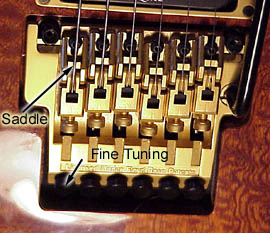 Floyd Rose Tuning Bridge |
Many solid body have a bridge that allow to attach a whammy bar. You can use it to provide a little vibrato to the tone or even for some "dive bombs", that means lowering the tone over a range of many semitones. With a normal bridge/nut combination that can be a problem, cbecasue it might detune the whole guitar severely even when the whammy bar is back in normal position. One bridge/neck combination that provide a whammy bar that doesn't detune the guitar is the Floyd Rose tuning bridge combined with locking nuts. Once you have coarsely tuned the guitar, you lock the nuts - the strings are frimly clamped at "fret zero". The fine tuning can be achieved with the tuning system of the bridge. The disadvantage is, that you cannot string a guitar that has such a tuning system with strings that are heavier than .010s, the locking nuts might be desturbing when playing at lower frets (fret 1 and 2) and that you have to have a suitable wrench with you to enable you to do the coarse tuning, when the guitar is really out of tune. If you don't have it with you, you are screwed. |
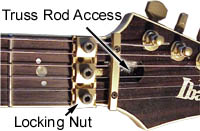
The pickups
not only pick up the sound of the strings, but take a lot of influence on the sound of the guitar that comes out of the amplifier. They consist out of a coil and a magnets and convert the vibration of a string into oscillating voltage which is amplified in the amplifier. There is a wide variety of different pickups for many different basic sounds. Pickups can be classified as single coil pickups and humbuckers (that is made out of two coils). Humbuckers don't hum as much as single coils (becasue the huimming inducted by lights transformers etc. nearly cancels out in two coils). They have a warmer sound and a "hotter" output (they are louder). Single coils produce more treble (high frequency are attenuated less).
The position of a pickup also characterizes the tone. The neck pickup has more bass and mids, thus sounds warmer, the bridge pickup picks up the high order harmonics better and sounds funkier. For a warm and jazzy sound, you'd probably choose a humbucker at neck position, for a screaming distored sound (the distortion happens in the amp!) a single coil or single coil sized humbucker at bridge position will do it.
The 5-position switch
switches the pickups on and off. Guitars with thee pickups usually have a 5-position switch, guitars with two pickups have a 3-position switch. The combinations that are stwiched on a 5-position swicth are "neck", "neck+middle", "middle", "middle+bridge" and "bridge" pickup. The combination of two pickups stwitched on produce pretty sweet sounds and have kinda humbucking effect (two coils, different poles of the magnets up). The combinations of a 3-position switch are "neck, "neck+bridge" and "bridge".
The volume and tone control
The volume control is usually a potentiometer that devides the output voltage of the pickup(s). I have seen some poor guitar circuitry that control the volume by using the pot(entiometer) as a variable load resistor. This does not only change the volume, but it also changes the tone, which is a not desired effect. Most guitars with two pickups have a separate volume control for each pickup, most guitars with 3 pickups have only one volume controll for all pickups - personally I don't care for it, since I usually play with the volume control cranked up all the way.
The tone control also uses a pot in conjuction with a capacitor, that forms avariable low pass filter. It attenuates high frequencies more or less depending on what you have dialed in. The number of tone controls on a guitar can vary. There are usually one or two of them. Guitars with three pickups usually have a separate tone control for the neck and the middle pickup and no tone control for the bridge pickup - you want the high frequencies for a good destorted sound anyway when you switch on the bridge pickup. Guitars with two pickups usually have a separate tone control for every pickup.
The output jack
Well, not much to say about the output jack, except that a worn out output jack really sucks. It produces some crackling noise. To prevent the wearing out of the jack, you can wrap the guitar cord once or twich around the strap before you plug it in. This works like a strain relief.
The cord
connects the guitar to the amplifier. It transports the pretty low output signal (the peak to peak voltage is usually way less than 1 Volt) of the pickups. It is obvious that it has to be well shielded to prevent picking up electro magnetic noise from lamps, transformers etc. A fact that is neglected pretty often is that the cable has a noticeable influence on the guitar tone. A cable has a certain inductivity and a certain capacity, thus a certain resonance frequency. In the "old days" guitars came with a cable, which was optimized for the pickups. I have been experimenting with different cables some years ago. The rule of thumb is, don't use a really long cable, if you don't have to use a really long cable.
Spiral cables might be handy, but they pick up a lot of noise (they are formed like an inductor, so what did you expect?).
The strap
is not only useful when you play while you are standing. It helps to keep the guitar "in place" when you are sitting, too. This way you can concentrate on playing instead of struggleing with your axe. What is the right position of the guitar? Well, if you hold the guitar at your knees it looks way cool, but you will experience certain restrictions when playing. If your music allows you to do it this way, go for it! The guitar has to feel comfortable and you have to be able to play for several hours without putting too much stress on the wrist of your left hand.
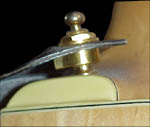 Strap lock |
I strongly recommend the use of strap locks. The strap is usually attached to the guitar with nothing else than a cheesy buttonhole. This is not very safe and in history of mankind thousands of guitars followed the gravity and hit the ground because the slipped out of the buttonhole. A strap lock is usually firmly attached to the strap and the connection between the straplock and the guitar is reliable. |
The stand
is not a part of the guitar, but a good way to store your axe when you don't play it - in case there are no cats or small children around, if so, strore it in a case. It should be stable and if it has a little baror strap to hold the neck in the crotch of the stand, go for it.

| [Next] | Tuning a guitar |
| [Up] | The Basics - not just for beginners |
| [Home] | Home Page |
| [Mail] | Send EMail to Sven's Guitar Site |
| [Contents] | Sven's Guitar Site Contents |

Last modified on Monday, 25. September 2017